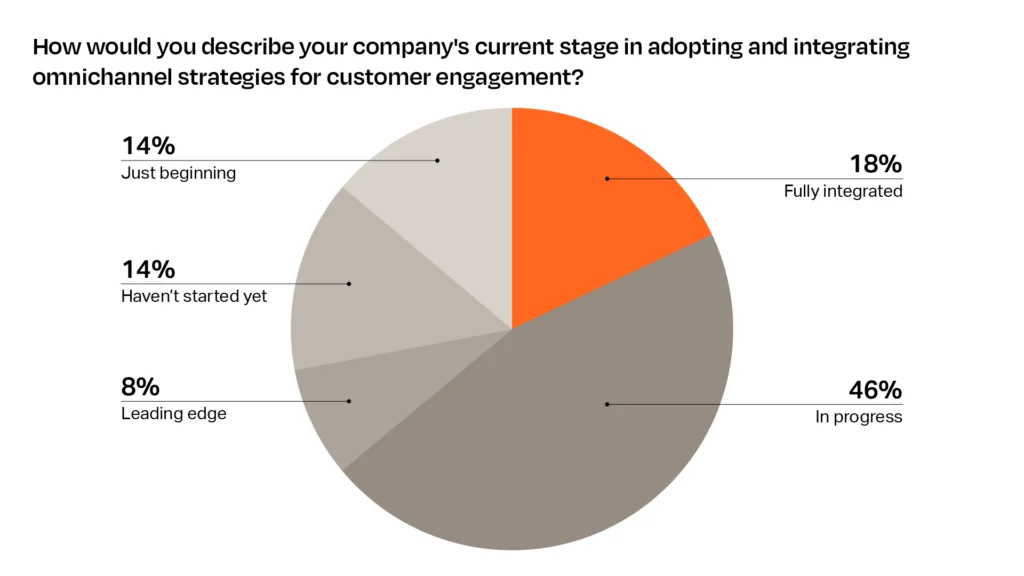

Key Takeaways
- The life sciences industry is embracing digital marketing evolution, focusing on omnichannel strategies and generative AI to enhance engagement and connect with consumers and patients effectively.
- Omnichannel marketing in life sciences involves integrating various channels for a seamless customer experience, but faces challenges like data silos and regulatory constraints that need to be managed.
- A clear distinction exists between multichannel and omnichannel approaches, with the latter prioritizing customer-centric, interconnected interactions across all platforms to meet individual preferences.
- The adoption of innovative strategies and responsible AI practices is crucial for overcoming regulatory challenges and driving successful marketing transformations in the life sciences sector.
Listen: Leveraging generative AI for remarkable life sciences marketing.
The life sciences industry is an exhilarating space for marketers, filled with incredible opportunities and innovations. Connecting products with consumers and patients is no small feat, and embracing cutting-edge strategies is essential. Today, we're diving into the evolution of digital marketing in life sciences, with a special focus on omnichannel strategies that unlock the potential of generative AI. Leveraging AI for content creation and hyper-personalization, we aim to engage customers with precision. But, as we move forward, responsible AI practices, ethical data use, and transparency remain crucial to avoid unintended consequences. Let's explore how technology is transforming our approach to marketing, sharing insights to captivate audiences in real time.
The digital marketing evolution in life sciences
Looking back at the evolution of digital marketing in life sciences, it's clear this industry has historically been cautious with new strategies. With good reason—life sciences is a highly regulated field, and effective engagement has always been a top priority. In the consumer world, brands moved from loyalty-focused models to engagement-driven approaches, as Harvard professor Youngme Moon highlights. In life sciences, engagement and loyalty have been intertwined from the start, with pharmaceutical sales teams building lasting connections with physicians to meet patient needs.
As digital channels expanded, the focus shifted to dynamic engagement models, integrating both offline and online interactions. Early attempts to leverage social media faced regulatory hurdles, but today, platforms like TikTok, Instagram, and Twitter are integral to digital marketing strategies, opening doors to data-driven marketing that enhances engagement.
The 2010s marked the rise of programmatic advertising and machine learning, trends that accelerated during the pandemic, pushing omnichannel integration and data-informed next-best actions. While regulatory constraints have made omnichannel adoption gradual, this ecosystem's heart lies in data-driven content marketing. Despite its benefits—better targeting, campaign optimization, and personalization—omnichannel faces hurdles like data silos, operational complexities, and slower insights. These challenges have slowed the industry's adoption of a true omnichannel approach, but the evolution continues, paving the way for life sciences to maximize digital marketing's potential.
The power and challenges of omnichannel strategy
A true omnichannel strategy connects various channels—websites, social media, email, and in-person interactions—into a seamless customer experience. By understanding customer preferences and tailoring messaging, life sciences companies can build stronger connections and drive conversions.
Yet, implementing an omnichannel strategy isn't without its challenges. Data silos, regulatory constraints, and cultural resistance are common obstacles. Companies need to invest in data integration, foster cross-functional team alignment, and promote a culture of innovation to overcome these hurdles.
Omnichannel versus multichannel: key differences
In a multi-channel approach, each channel—digital, in-person, or social—operates independently with its own strategy, focused on the brand. In an omnichannel strategy, however, all channels are interconnected with the customer at the center. This approach leverages customer insights to ensure each channel is fully integrated, empowering customers to access information whenever they need it. Omnichannel strategies prioritize individual customer preferences across sectors, whether engaging with employers, healthcare providers, or patients.
Gauging your omnichannel progress

To understand where you stand in your omnichannel journey, consider how you're engaging with your audience. Are you just beginning, or are you leading in fully integrated strategies? A recent industry poll revealed that most organizations are still in the “in progress” stage, with only a few at the forefront. Life sciences channels range from digital platforms to in-person sales avenues. The key to omnichannel success is integrating data across all channels to maintain a cohesive presence, even as the industry lags in adoption. If you're progressing, you're not alone. Many in life sciences are navigating similar challenges, making omnichannel integration an ongoing journey.
Steps for navigating the omnichannel path forward
Moving forward in an omnichannel world requires strategic foresight and leadership. Here are some key recommendations to guide your journey:
- Reevaluate Your Strategy: Strong leadership is crucial. Leaders must not only support but also articulate the importance of omnichannel integration for team collaboration and delivering real value to end customers and patients.
- Invest in Upskilling: Technology investments are just the start. Equally important is upskilling your analytics, marketing, and commercial teams so they're ready to fully leverage new capabilities.
- Adopt an Agile Approach: Prioritize quick wins to stay flexible. Agile adjustments, focusing on customer engagement, ensure that each channel consistently provides value.
- Engage Internal Champions: Leverage experienced colleagues who can share past insights, helping to build a network of champions and believers in your mission.
- Resource and Manage Wisely: Reevaluate resource allocation as you move into more advanced phases of omnichannel adoption, incorporating emerging technologies like generative AI for impactful campaigns.
While the conversations around omnichannel and AI are extensive, many organizations are still making the shift. The value of getting it right is immense, especially as we enter a new era of technology adoption.
The rapid pace of technology and its impact on life sciences
Today's rate of technology adoption is unprecedented. For instance, ChatGPT reached a million users in just five days, underscoring how fast new technology is adopted. In life sciences, consumers and customers expect agility, speed, and creativity. Meeting these demands means prioritizing content at scale and hyper-personalization to stay competitive.
Generative AI: the next frontier in life sciences marketing
The shift toward generative AI is poised to revolutionize marketing in life sciences. Reflecting on our evolution from multichannel to omnichannel, we've built a foundation that enables generative AI to truly flourish. Now, we can streamline customer engagement across all touchpoints, providing a unified 360-degree view of each customer.
Generative AI brings transformative potential, enabling AI-driven campaigns, hyper-personalized interactions, and scalable content. Automating these processes boosts efficiency, enhancing speed and responsiveness. While costs are a consideration, they're offset by AI's initial gains in efficiency and reduced manual labor. Over time, costs stabilize as companies integrate these capabilities and compete in a bustling digital arena. With generative AI, we can navigate market noise, delivering targeted, data-driven experiences that resonate with consumers.
In the end, harnessing generative AI's potential equips us to deliver value to customers and patients with unparalleled precision, securing a competitive edge in this dynamic industry.
Related

Great brand collaborations are the best to strengthen identity.
Design & Experience, Insights & Trends, Marketing & Creative, Beauty and Fashion

Consumer demand and policy are driving EV market growth.
Development & Technology, Insights & Trends, Automotive

Are you missing opportunities to improve health screenings?
Design & Experience, Marketing & Creative, Health



